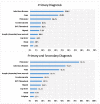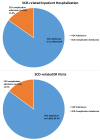Sickle cell disease complications: Prevalence and resource utilization
- PMID: 31276525
- PMCID: PMC6611562
- DOI: 10.1371/journal.pone.0214355
Sickle cell disease complications: Prevalence and resource utilization
Abstract
Objectives: This study evaluated the prevalence rate of vaso-occlusive crisis (VOC) episodes, rates of uncomplicated and complicated VOC episodes, and the primary reasons for emergency room (ER) visits and inpatient admissions for sickle cell disease (SCD) patients.
Methods: The Medicaid Analytic extracts database was used to identify adult SCD patients using claims from 01JUL2009-31DEC2012. The date of the first observed SCD claim was designated as the index date. Patients were required to have continuous medical and pharmacy benefits for ≥6 months baseline and ≥12 months follow-up period. Patient demographics, baseline clinical characteristics, the rate of uncomplicated and complicated VOC (VOC with concomitant SCD complications) episodes, and reasons for ER visits and inpatient stays were analyzed descriptively.
Results: A total of 8,521 patients were included in the analysis, with a median age of 30 years. The average follow-up period was 2.7 years. The rate of VOC episodes anytime in the follow-up was 3.31 in person-years. During the first-year follow-up period, an average of 2.79 VOC episodes were identified per SCD patients, with 1.06 VOC episodes treated in inpatient setting and 0.90 VOC episodes in ER without admission. A total of 76,154 VOC episodes were identified during the entire follow-up period for the overall SCD patients. Most of the VOC episodes (70.3% [n = 53,523]) were uncomplicated episodes, and 29.7% were complicated episodes. Using primary diagnosis claims only, the most frequent complications during the VOC episode were infectious diseases (25.9%), fever (21.8%), and pulmonary disorders (16.2%). Among ER and hospitalizations related to VOC or SCD complication, ~85.0% had VOCs as the primary reason for admission; 15.0% had SCD complications as the primary reason.
Conclusion: In summary, SCD and its related comorbidities and complications result in high acute health care utilization. In addition, VOC remains the primary reason for SCD patients' ER visits and inpatient admissions.
Conflict of interest statement
I have read the journal's policy and the authors of this manuscript have the following competing interests: This study was funded by Novartis Pharmaceuticals Corporation which is a commercial company. The funder provided support in the form of salaries for authors JP and MB. The funders also provided consultation fees to STATinMED Research, employer of LX, which is a paid consultant in connection with this study and the development of this manuscript. The funder provided support to NS in the form of research funding, consultant fees, and speaker’s fees. HY has nothing to disclose. However, the funder did not have any additional role in the study design, data collection and analysis, decision to publish, or preparation of the manuscript. There are no patents, products in development, or marketed products associated with this research to declare. This does not alter our adherence to PLOS ONE policies on sharing data and materials.
Figures





References
-
- Hassell KL. Population estimates of sickle cell disease in the U.S. Am J Prev Med. 2010;38(4 Suppl):S512–21. - PubMed
Publication types
MeSH terms
LinkOut - more resources
Full Text Sources
Medical

